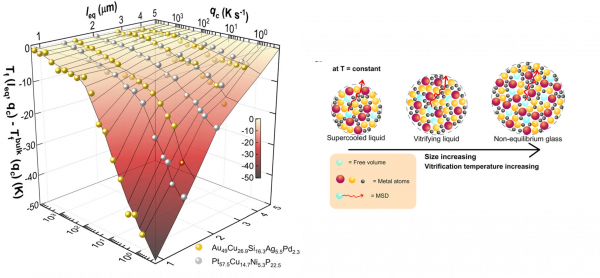Size-dependent vitrification in metallic glasses
Metallic glasses are materials of extraordinary importance due to their superior mechanical properties and corrosion resistance. A well-known and widely investigated aspect, which deeply impacts the metallic glass final properties, is that their thermodynamic state depends on the processing conditions employed to produce them.
Hitherto the way reducing the sample size affects the glass thermodynamic state of the metallic glass and the implications on their final properties remains much less investigated. This work presents a study on the way vitrification –the transformation to a glass on cooling the liquid – takes place in two metal alloys based on gold and platinum, depending on certain conditions. More specifically, the sample size and applied cooling rate are varied using state-of-the-art fast scanning calorimetry that permits achieving heating/cooling rates as large as 40000 K/s. The key result of the study is that reducing the sample size to the micrometer scale allows conveying the glass to low energy/high density states, as parametrized by the fictive temperature, Tf, of the glass. While this effect is minimized in glasses cooled at high rates, cooling at rates of several K/s or lower allows attaining reduction in Tf of as low as 40 K below the glass transition temperature of the metal alloy for the smallest samples, a reduction that would require geological time scales in a bulk glass. Applying the free volume holes diffusion model allows capturing this phenomenology – where enthalpy reduction /density increase is assisted by release of free volume to the free interface.
These findings have profound implications on both technological and fundamental perspectives. They show how low energy/high density metallic glasses can be produced on time scales of seconds simply reducing the sample size. In this way, they open the door to reaching thermodynamic states otherwise unattainable on conventional bulk glasses in time scales accessible to the human being, thereby allowing exploring the fate of the thermodynamic state of a glass deep in the energy landscape. Specifically, the long-standing issue of the existence of a true thermodynamic transformation into the so-called “ideal glass”, recently unveiled in polymeric glasses, can be explored in metallic glasses too, involving times scales amenable to the experimental practice.

Figure: (left) Tf reduction with respect to the bulk as a function of cooling rate, qc, and sample size, leq, for gold and platinum based metallic glasses and (right) schematic plot of the free volume holes diffusion model.



